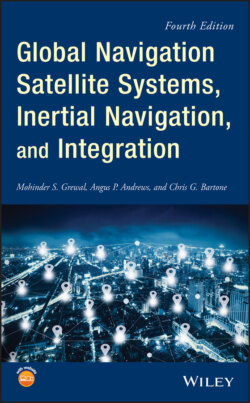Читать книгу Global Navigation Satellite Systems, Inertial Navigation, and Integration - Mohinder S. Grewal - Страница 128
Coning Motion
ОглавлениеThis type of motion is a problem for attitude integration when the frequency of motion is near or above the sampling frequency. It is usually a consequence of host vehicle frame vibration modes or resonances in the INS mounting, and INS shock and vibration isolation is often designed to eliminate or substantially reduce this type of rotational vibration.
Figure 3.14 Strapdown attitude representations.
Coning motion is an example of an attitude trajectory (i.e. attitude as a function of time) for which the integral of attitude rates does not equal the attitude change. An example trajectory would be
(3.20)
(3.21)
where
is the rotation vector,
is called the cone angle of the motion,
is the coning frequency of the motion,
as illustrated in Figure 3.15.
The coordinate transformation matrix from body coordinates to inertial coordinates will be
(3.22)
Figure 3.15 Coning motion.
and the measured inertial rotation rates in body coordinates will be
(3.23)
The integral of
(3.24)
which is what a rate integrating gyroscope would measure.
Figure 3.16 Coning error for 1° cone angle, 1 kHz coning rate.
The solutions for and are plotted over one cycle (1 ms) in Figure 3.16. The first two components are cyclical, but the third component accumulates linearly over time at about radians in one millisecond, which is a bit more than deg/s. This is why coning error compensation is important.
